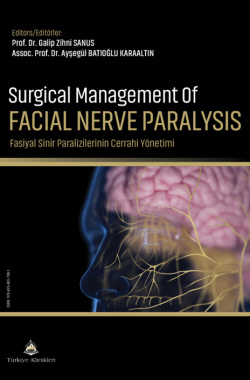Electrophysiologic Evaluation of the Facial Nerve
Turgut ADATEPEa, Adile ÖZKANb
aİstanbul Training and Research Hospital, EMG Laboratory, İstanbul, Türkiye
bTürkiye Hospital, Clinic of Neurology, İstanbul, Türkiye
Adatepe T, Özkan A. Electrophysiologic evaluation of the facial nerve. In: Sanus GZ, Batıoğlu Karaaltın A, eds. Surgical Management of Facial Nerve Paralysis. 1st ed. Ankara: Türkiye Klinikleri; 2022. p.37-46.
ABSTRACT
The most valuable in the evaluation of the facial nerve is the anamnesis and clinical examination. Electrophysiological examinations are a supportive diagnosis method. Electrophysiological tests used for facial nerve are Nerve Stimulation Test, Maximal Stimulation Test, Electroneurography, Electromyography, Blink Reflex, and Transcranial Magnetic Stimulation. There are two main purposes in performing electrophysiological tests, rather than the normal-pathological distinction. The first is the localization of the lesion, and the second is to determine the type of lesion. After these two are realized, questions about regeneration-degeneration and prognosis can be answered clearly.
Keywords: Electrophysiology; electroneurography; electromyography; blink reflex
Kaynak Göster
Referanslar
- Laumans EP, Jongkees LB. on the prognosis of peripheral facial paralysis of endotemporal origin. Ann otol Rhinol Laryngol. 1963;72:621-36. [Crossref] [PubMed]
- May M, Harvey JE, Marovitz WF, Stroud M. The prognostic accuracy ofthe maximal stimulation test compared with that of the nerve excitabilitytest in Bell's palsy. Laryngoscope. 1971;81(6):931-8. [Crossref] [PubMed]
- Fisch u, Esslen E. Total intratemporal exposure of the facial nerve.Pathologic findings in Bell's palsy. Arch otolaryngol. 1972;95(4):335-41. [Crossref] [PubMed]
- Marey EJ. Le vol des oiseaux. 1st ed. Paris: Masson; 1890.
- Kugelberg E. [Facial reflexes]. Brain. 1952;75(3):385-96. undeterminedLanguage. [Crossref] [PubMed]
- Barker AT, Jalinous R, Freeston IL. Non-invasive magnetic stimulation ofhuman motor cortex. Lancet. 1985;1(8437):1106-7. [Crossref] [PubMed]
- Robinson L, Stolp KA. Evaluating the Patient With Focal NeuropathyWith Needle Electromyography. In Numbness, Tingling, Pain, and Weakness: A Basic Course in Electrodiagnostic Medicine - AANEM. JohnsonPrinting Co. Rochester. 2005.
- Watson JC, Daube JR. Compound muscle action potentials. In: DaubeJR, Rubin DI, eds. Clinical Neurophysiology. 3rd ed. New york: oxford universityPress; 2009. p.327-68. [Crossref] [PubMed] [PMC]
- Glocker Fx, Magistris MR, Rösler KM, Hess CW. Magnetic transcranialand electrical stylomastoidal stimulation of the facial motor pathways inBell's palsy: time course and relevance of electrophysiological parameters. Electroencephalogr Clin Neurophysiol. 1994;93(2):113-20. [Crossref] [PubMed]
- Adatepe T. Muscles of head (musculi capitis). In: Adatepe T, Ertaş M,uzun N, Stalberg E, eds. Comprehensive Guide and Muscle Atlas forNeedle Electromyography. İstanbul: Sep Medical Publishing; 2014. p.28-51.
- Adatepe T, uzun N, Gündüz A. A method for recording facial motor response over occipitalis muscle. Neurophysiol Clin. 2015;45(3):221-2. [Crossref] [PubMed]
- uzun N, Adatepe T, Azizli E, Alkan Z, yiğit Ö, Gündüz A, Karaali-SavrunF. A novel muscle for electroneurography in peripheral facial palsy: occipitalis. Eur Arch otorhinolaryngol. 2016;273(3):755-60. [Crossref] [PubMed]
- Daube JR, Rubin DI. Needle electromyography. Muscle Nerve.2009;39(2):244-70. [Crossref] [PubMed]
- Rubin DI. Normal and abnormal spontaneous activity. Handb Clin Neurol. 2019;160:257-79. [Crossref] [PubMed]
- Preston DC, Shapiro BE. Clinical-Electrophysiologic Correlations. Electromyography and Neuromuscular Disorders. 3rd ed. London: ElsevierSaunders; 2013. p.125-266. [Crossref]
- Rubin DI. Needle electromyography: basic concepts and patterns of abnormalities. Neurol Clin. 2012;30(2):429-56. [Crossref] [PubMed]
- Kim JE, Seok JM, Ahn SW, yoon BN, Lim yM, Kim KK, et al. Basic concepts of needle electromyography. Ann Clin Neurophysiol. 2019;21(1):7-15. [Crossref]
- Katirji B. Peripheral nerve hyperexcitability. Handb Clin Neurol.2019;161:281-90. [Crossref] [PubMed]
- Rubin DI. Normal and abnormal voluntary activity. Handb Clin Neurol.2019;160:281-301. [Crossref] [PubMed]
- Kimura J, Rodnitzky RL, okawara SH. Electrophysiologic analysis ofaberrant regeneration after facial nerve paralysis. Neurology.1975;25(10):989-93. [Crossref] [PubMed]
- valls-Solé J. Electrodiagnostic studies of the facial nerve in peripheral facial palsy and hemifacial spasm. Muscle Nerve. 2007;36(1):14-20. [Crossref] [PubMed]
- Smith BE. Cranial reflexes and related techniques. In: Daube JR, RubinDI, eds. Clinical Electrophysiology. 3rd ed. New york: oxford universityPress; 2009. p. 529-42. [Crossref]
- Ghonim MR, Gavilan C. Blink reflex: prognostic value in acute peripheralfacial palsy. oRL J otorhinolaryngol Relat Spec. 1990;52(2):75-9. [Crossref] [PubMed]
- Heath JP, Cull RE, Smith IM, Murray JA. The neurophysiological investigation of Bell's palsy and the predictive value of the blink reflex. Clinotolaryngol Allied Sci. 1988;13(2):85-92. [Crossref] [PubMed]

